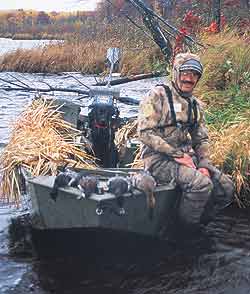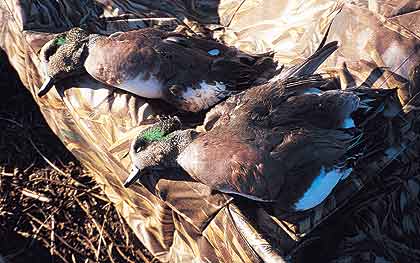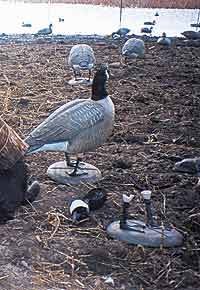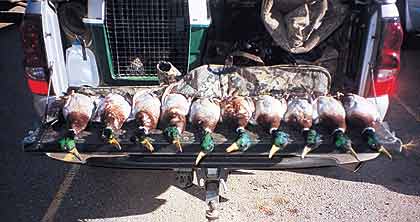November 03, 2010
By Jay Strangis
It's not always fast, but it sure is pretty
By Jay Strangis
 The G-man, with mallards pulled from a tough slough hunt. |
The great thing about waterfowl hunting, especially in my part of the world, is that every season is different, unique in character, like kids from the same family with personalities each their own; some quiet, some boisterous but all filled with surprises.
What's the next season going to be like? One could consult the Old Farmer's Almanac, throw darts at a board or look at the stripes on caterpillars, none of which is likely to get you any closer to the truth, because one hard frost, one spell of Indian Summer or one nasty arctic blast could change everything for better or worse, and a 60-day window doesn't offer much wiggle room where bad news is concerned.
Advertisement
We have a unique situation here in the upper Midwest. We're caught between worlds. We breed a few ducks in Minnesota, it's true, but most of the birds come from somewhere else to head for somewhere else. We produce a fair number of ring-necked ducks up north, some mallards and a few bluebills, too. In the western part of the state we breed blue-winged teal, mallards, some pintails and a few canvasbacks, but none in any great numbers. Of course, wood ducks nest across the state, but like the blue-wings, they can migrate quite early, too early, if things don't suit them.
So we wait. We gun the early birds, and then we wait for the first trickle of migrants. Mostly they filter through on weak cold fronts, arriving from their starry-skied night flights in traditional stopping places not unknown to the likes of us. Some, like the canvasbacks and some honkers, are calendar birds, dependable to arrive cold front or not. But most fowl are fickle, unpredictable creatures, which is why we hunt.
Advertisement
Occasionally, we catch them right, though many times we are wrong, and once every so often when wind and cold and the urge collide, they pile in, and the shooting is fast.
Seeking Opportunity
Waterfowl hunters are opportunists. I, and my hunting buddies, fit right into that mold. Would that we could hunt every day, but sadly, most of us have commitments to jobs, families, and all the regularities of life that limit our time afield. But limit is a relative term, especially if you ask our wives. We keep our eyes to the sky, our ears to the ground and our hand on the weather dial. We don't want to miss anything.
So it was a few years ago when in the early season I drove to another county to put up a deer stand and in the process of that day, stumbled upon some very comfortable Canada geese. The birds were happily roosted in a fairly new beaver pond, secluded in the center of a section of land. Had I not been perched high in a tree that stood high on a hill, I might have missed them. As it was, I saw a handful fly out, then another handful, plus a few more. I climbed higher to strain to follow their trails and saw them dump over a wood line a quarter mile south.
 End of a foggy morning, Boris, a blurry photo and the results of Lake X. |
When I approached the old farmer's door he was already at the screen. Not his field, he told me, but the man who leased it was the Ag agent in town. I might ask him. The field was only 10 acres, 20 if you count the adjoining woods, the agent explained from behind the county extension counter where he worked. He had leased it to hunt with his son, mostly for deer, but they might hunt the geese, too. I sensed some hesitation in those last words and asked if he might let us set the field up for him and share the hunt with he and his son. The idea took, and we shook hands and agreed to meet at the field at 6 a.m. All he needed bring was his son and their guns.
I quickly called two of my friends to explain the details. Arriving at the field with our decoys, we found the father and son already parked alongside. We set a quick small, spread and didn't have to wait long for the geese. We botched the first couple of bunches due to lack of stubble cover, but when we moved to the high grass on the field edge to sidewind the circling birds the ruse worked. Before the last flock had flown the father had to leave to get the boy to school. We thrust large goose necks into their palms and thanked them for allowing us to join them, and the boy likely spent the rest of that day telling his friends about his first goose hunt. It was a scratched together affair, but one with a whole lot of feel good about it.
Harder Than It Should Be
I've been hunting in North Dakota for a number of years and stay at the same shack in an area that doesn't have a lot of permanent water, so is subject to the whims of seasonal moisture. This had been a wet year, but the birds were fairly gunned out, well scattered in the various ponds, and nothing much new had arrived. It was a search and search affair, rather then search and destroy. I finally found birds sprinkled across a shallow, weedy marsh that's maze of reeds hid their true numbers. They looked quite comfortable, and huntable and the farmer agreeable. The other guys weren't going to arrive until later in the day, so I gathered some old fence posts and grass panels and later we crafted them into a quick blind.
The following morning with a fairly howling wind we waded to the point, set our decoys and waited. Just before shooting light a flock of snow geese in staggered windblown ranks swarmed right into the spread, all but landing before flaring up and back in the wind. We cursed their timing. Laying into a flock of snows on a marsh miles from their refuge roost would have been the luckiest of events, and likely one not seen again.
The first ducks of the morning traded in and out of the marsh, banking toward us then fading back in the wind.
A portent of things to come; educated birds that, as we soon learned, wanted the back coves of weed beds rather than decoys on points on open water. We adjusted the spread to force them into range, helping a little. We scratched down a couple of early mallards before my partners headed across the marsh in our small boats with a few decoys in tow.
 Wigeon worked the mud-frozen remnants of a bean field mixed right in with the mallards. |
They hid within separate hidey-holes in the reeds, hoping for a m
istake from the birds that now had all but ceased their flights. A lone drake mallard made a high, wide assault on my position and I stoned him via a horrendous lead. The boys brought down one more mallard and we abandoned ship in favor of more scouting in this tough country. Before our hunt days were over we'd have scratched nearly a limit out of hidey holes and barley fields, and even pounded honkers from small wheat fields hidden in the hills; none, of it easy, but far from ugly, and even pretty at times.
Waiting For Lake X
In the middle of the bog country not far from where I live there are a number of good wild rice lakes; small but deadly little diver duck magnets that draw new birds when migrant numbers build with various weather fronts. Ducks usually don't roost these lakes, they've got safer, bigger waters to do that; the prospect of food brings them to the small lakes. Any day of the week at any time during the season would be fine to hunt one of these spots to scratch out a couple of birds, but they get better when bird concentrations build during the season. We like to hunt one we call Lake X.
Many years ago, this lake would have been ours alone on most any day, except perhaps during the peak of a bluebill migration, but now it has been discovered by a few who value it as much as we do. Our season had been in the doldrums, but a "right" wind was promised when Boris Popov and I arrived at Lake X a couple of years ago. Being older than we once were, we found ourselves the third vehicle at the swampy boat landing in the darkened depths of pre-dawn. Late, we told ourselves as we pushed the boat from the trailer. We would try to scratch a hunt out of this scene.
Only the slightest breeze moved and the clouds hung so low that they scudded the water with mist. We felt our way through the damp dark led on only by memory, but the dim beams that told of other hunters reached us as we navigated the open water, revealing locations we guessed we knew. We chose a shore well away from the others, one not without promise, especially if the wind came up as predicted. Before we could even see our shore we began dropping decoys in a long arc that would end at our blind. The exaggerated string of birds were spaced far apart, bluebills, coursing 500 yards of open space before reaching he edge of the small set in front of our hide.
 Leftovers of a cold morning collision between a drake mallard missile and a full body decoy. |
We pulled the boat close to the boggy€‚bank of weeds, flipped up our grass blind and become one with the shore. Day began to show and the first shots came from across the lake. We saw nothing, nor could we have, the clouds hanging so low that they swallowed up the last half of our decoy line as it trailed out into the lake. The breeze quickened, the clouds opened then closed again and again.
A flock of ducks at full speed appeared over the lake and were swallowed up again by clouds. Suddenly a flock was heading for the deck in front of us coming straight on a breakneck speed. In two seconds they were at the outer edge of the spread, in a millisecond ripping upwards just in front of us and as suddenly two shots roared with no chance of another. Two bluebills kicked on their backs in rippled concentric rings. Two veteran hunters sat stunned by the velocity of the moment.
Buddy, then a pup, retrieved the birds with encouragement and in seconds another flock was upon us as swiftly as the first. Cans! One quick shot from Boris' side and a heavy bird fell over his right shoulder. Buddy found her back in the floating bog, supported by the leatherleaf plants, the living mesh that holds the sphagnum together. The wind rose to another level, another flock rocketed in on my side and a last duck fell to the water. The morning hunt was over, but we had scratched out a few more memories from Lake X, despite our timing.
Frozen Mud
I'm not a doctor, but I'm on call during much of the fall, especially during the month of November; freeze up time for us, and our last whacks at birds. In Minnesota, we usually run out of water, turned to ice before we run out of season. North Dakota is little different, though the birds may hang-in longer fighting to keep holes open as long as the grain doesn't get buried under snow.
My friend John called Jack and I. It was opening weekend of deer season in North Dakota, but John had found some birds that might not last the week. It's worth mentioning that North Dakota during deer season is not the North Dakota most know. Posted signs have sprung up everywhere, and each farmer has his city kin to entertain with big brown targets and home-cooked meals. Waterfowlers represent a sideshow no longer entertaining to landowners.
John had, however, scratched it together, gaining permission to hunt this particular piece of property. Battle stations! Jack and I were on our way. The following morning we were in full assault mode on sheetwater in harvested corn. The wet had kept the combine out of this low spot giving us just enough standing stalks to hide in. The muddy scene met with favor among mallards, and the early assault, a melee of wings, took place in a gloom so grey and dark that what we perceived looked more like a plague of moths. Despite it being legal shooting time, the ghostliness and our better judgment precluded shooting. Why shoot hens?
The air grew colder as the light increased. We were in no hurry, and as the mud froze we finished the last of our birds. One of the last, a first-pass drake mallard we were still sending hails to, was suddenly stoned at high altitude by a load of John's metal. I watched the feathered meteor grow larger, larger and larger realizing at the last second its direct-hit course. I raised my arms to protect myself just as the bird struck a full-body goose next to my head, exploding plastic and parts in all directions like an IED. I checked my dog; nobody apparently hurt, and we all had a good holy s%@# laugh.
 What can you say? Sometimes things just go right, even on frozen mud. |
As we tidied up our gear back on the road, a truck approached; and not your ordinary truck. We shared a bit of uncomfortable BS with the game warden. He likely had been doing his deer duties when attracted to our shooting, so he had stayed for the show. He checked our birds, an exact limit, but apparently he'd seen a couple of the birds we had sailed. As he checked the birds we went back to our tasks, but he approached each of us individually, and as we later sorted out, asked each of us the same subtle question. Had we lost any birds in the field?
We'd collected both the long birds on the way out with the help of the dogs, and having two good dogs with us, there was no doubt among us that all were accounted for. Besides, birds aren't that hard to find on frozen mud
. Still, it seemed he had decided this the best way to bust a trio of honest hunters. I'm not sure that losing a bird is a violation, if you've done all you can to retrieve it, or that a lost bird counts against your limit, except in a personal, ethical sort of way. Having accounted for every bird, we collectively agreed that whatever he was getting at was dirty pool, which lowered our affection for him considerably.
That afternoon, we found another mass of birds among the mud-frozen remains of a soybean field; another gift from the gods. The next morning, lacking one bit of cover of any sort, we used the layout blinds on the cold, hardened mud alongside an iced-over piece of sheetwater, to slay both wigeon and mallards. For a scratched together hunt, this one would go down in the books.

